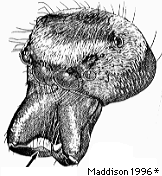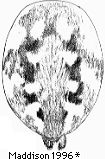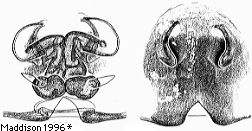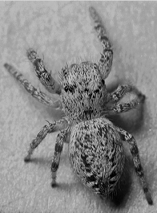Pelegrina balia
Introduction
A large western species with light brown and beige markings. The male can be identified by the broad side bands of the carapace and the flange on the fang. The embolus is narrow, very similar to that of chalceola, but it leans slightly and the erect portion broadens gradually into base. The tibial apophysis of balia usually points more distally than in chalceola. The female can be identified by the spotted abdomen and the epigynum, which differs from that of the sympatric aeneola in having the surface rise gradually behind the flaps.
Figures

 1
1
 2
2
 3
3
 4
4
 5
5- Male face
- Palpus
- Female abdomen
- Epigynum
- Female (AZ)
Natural History
On Juniperus occidentalis (3 records), Pseudotsuga (2 records), Cupressus macnabiana (1 record), Abies (1 record) and Calocedrus (1 record) in Oregon and northern California. From juniper woodland in California (5 records). Over the entire range, 3M were collected in April, 10 in May, 3 in June and 1 in September.About This Page
Included on this page are images and text from Maddison, W.P. 1996. Pelegrina Franganillo and other jumping spiders formerly placed in the genus Metaphidippus (Araneae: Salticidae). Bulletin of the Museum of Comparative Zoology. l54(4): 215-368. These images and text are copyright © 1996 The President and Fellows of Harvard CollegePage copyright © 1995 Wayne Maddison
All Rights Reserved.
Citing this page:
Tree of Life Web Project. 1995. Pelegrina balia . Version 01 January 1995 (under construction). http://tolweb.org/Pelegrina_balia/5021/1995.01.01 in The Tree of Life Web Project, http://tolweb.org/






 Go to quick links
Go to quick search
Go to navigation for this section of the ToL site
Go to detailed links for the ToL site
Go to quick links
Go to quick search
Go to navigation for this section of the ToL site
Go to detailed links for the ToL site